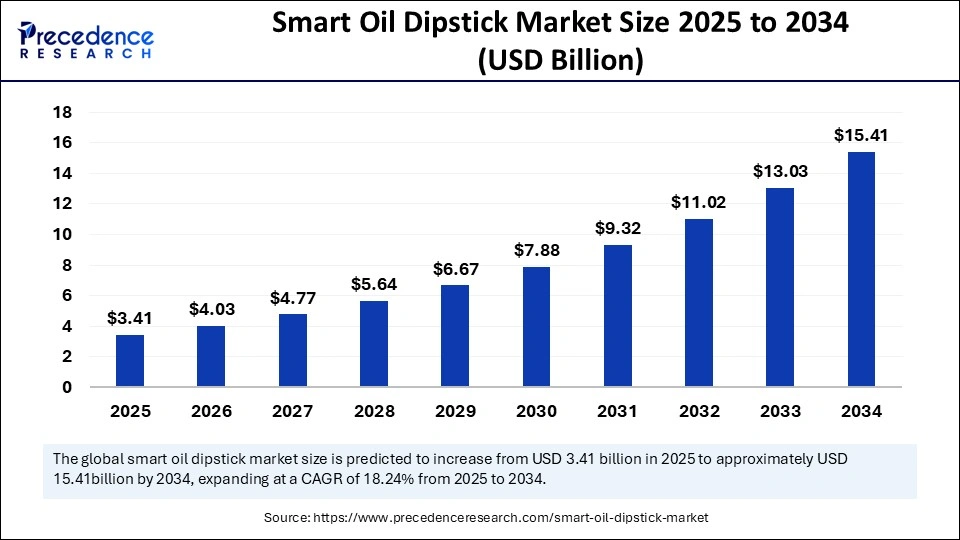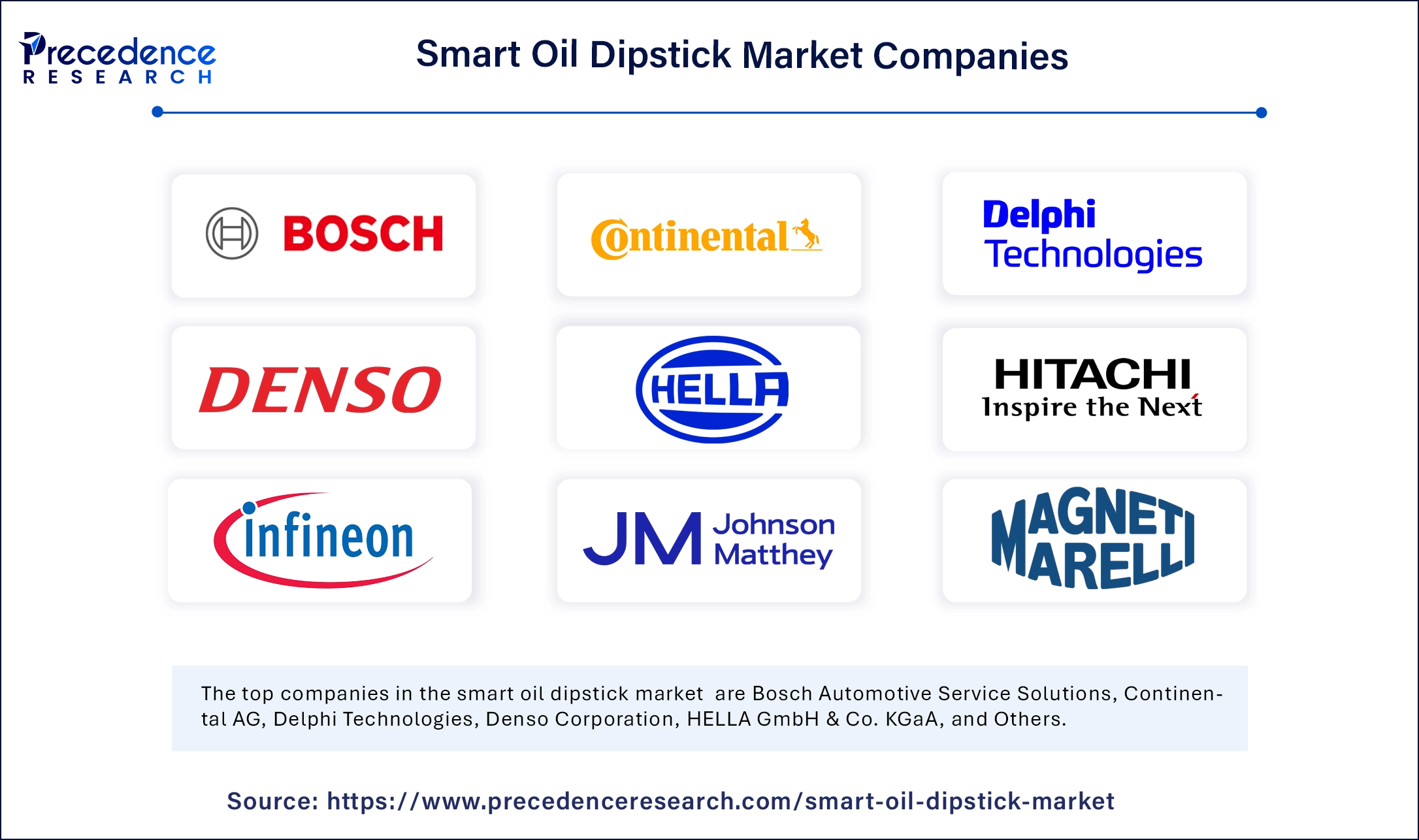January 2025
The global smart oil dipstick market size accounted for USD 3.41 billion in 2025 and is forecasted to hit around USD 15.41 billion by 2034, representing a CAGR of 18.24% from 2025 to 2034. The market sizing and forecasts are revenue-based (USD Million/Billion), with 2024 as the base year.
The global smart oil dipstick market size was estimated at USD 2.89 billion in 2024 and is predicted to increase from USD 3.41 billion in 2025 to approximately USD 15.41 billion by 2034, expanding at a CAGR of 18.24% from 2025 to 2034. The rising awareness among consumers regarding preventive maintenance is boosting the growth of the smart oil dipstick market.

Artificial Intelligence (AI) is being widely incorporated into the smart oil dipstick, enabling real-time monitoring features that let the user analyze data in real time and make informed decisions. The sensors on the dipstick can provide more accurate and reliable information. However, AI helps in analyzing and interpreting this information, which further helps improve the performance of the vehicle or machinery. AI technology helps in the detection of early signs of contamination or degradation of oil through vast data analysis. AI and machine learning (ML) algorithms analyze huge amounts of data and can identify patterns or potential problems. This helps avoid any sudden disruptions and downtime through proactive maintenance. AI technology helps in optimizing a maintenance schedule according to the vehicle and machinery’s usage. Remote monitoring is a major benefit of integrating AI technology. It can help the data to be transmitted wirelessly and perform real-time analysis of the oil condition.
Smart oil dipstick is a sophisticated automotive device, which consists of sensors and real-time monitoring to monitor the oil levels and conditions in vehicles. The use of smart oil dipsticks enhances the accuracy and convenience through wireless transmission of oil-related data. An exponential increase in the utilization of various digital and smart technologies in everyday life has boosted the growth of this market. Consumers are becoming more aware of the benefits of regular maintenance and preventive care for their equipment and vehicles. This is a key factor that is aiding the growth of this market. The rapid increase in utilization and demand for connected devices is driving market growth. The growing demand for vehicles and machinery that are energy efficient is boosting market growth. The widespread integration of advanced and innovative technologies into the industrial and automobile sectors is further fueling the market growth. Stringent regulations regarding fuel efficiency and environmental impact are boosting the demand for such energy-efficient solutions.
| Report Coverage | Details |
| Market Size by 2034 | USD 15.41 Billion |
| Market Size in 2025 | USD 3.41 Billion |
| Market Size in 2024 | USD 2.89 Billion |
| Market Growth Rate from 2025 to 2034 | CAGR of 18.24% |
| Dominated Region | Asia Pacific |
| Fastest Growing Market | North America |
| Base Year | 2024 |
| Forecast Period | 2025 to 2034 |
| Segments Covered | Type, Technology, Application, Sales Channel, and Regions |
| Regions Covered | North America, Europe, Asia-Pacific, Latin America and Middle East & Africa |
Increasing Demand for Smart and Connected Technologies
The increasing demand for smart and connected technologies in vehicles is a major factor driving the growth of the smart oil dipstick market. The rising utilization of smart devices and various connected devices has led to an increased demand for such technologies in vehicles. Connected technologies create a platform for integrating smart dipsticks. Integrating smart dipsticks with connected technologies enhances data collection and analysis of predictive maintenance. The adoption of the Internet of Things (IoT) and Bluetooth connectivity has increased in vehicles, making it easy to integrate smart dipsticks. As consumers are shifting toward more energy-efficient vehicles, the utilization of smart oil dipsticks is increasing. Smart oil dipsticks monitor oil quality and temperature in real-time, optimizing engine performance and energy efficiency of vehicles. According to the International Energy Agency (IEA), in 2023, nearly one in five cars sold were electric. This shows the rising trend toward energy-efficient vehicles.
High Cost and Compatibility Issues
The smart oil dipstick market faces certain challenges that are limiting its growth. While smart oil dipsticks have many benefits that help improve the energy efficiency of vehicles, they are costlier than conventional oil dipsticks, which limits the growth of the market. Moreover, smart oil dipsticks can lack scalability in some vehicles, which further limits their utilization. For example, automobile manufacturers cannot widely use this feature in all their vehicles, especially those in the low-price range.
Rising Vehicle Electrification and Technological Advancements
The rising vehicle electrification and rapid shift toward electric vehicles create immense opportunities in the smart oil dipstick market. EVs require different maintenance solutions, like smart dipsticks. The growing environmental awareness amongst the population and stricter regulation for reducing environmental impact are boosting the adoption of EVs. This could open a new avenue for growth and innovation for the smart oil dipstick market. In addition, advancements in sensor technology are enabling the development of sophisticated oil dipsticks, fueling the growth of the market.
The anti-corrosion segment dominated the smart oil dipstick market in 2024. Anti-corrosion smart oil dipstick is designed to be resistant to corrosion, ensuring accurate readings. It plays an important part in different industries because environmental factors can accelerate corrosion. The corrosion-resistant materials and coatings utilized in these dipsticks help improve durability and resilience. This type of dipstick is ideal for harsh environments like high humidity and temperature. Thus, they are widely used in combustion engines and industrial equipment.
Meanwhile, the steam jacket segment is projected to grow at a significant rate in the coming years. Steam jacket dipsticks help regulate or elevate the temperature of the oil being checked and keep it in a fluid state. They are widely used in industrial machinery. They control oil temperature and enhance the performance of machinery.
The cellular segment led the smart oil dipstick market in 2024 and is expected to sustain its growth trajectory in the coming years. The offering of connectivity features and real-time data transmission capabilities make this technology a popular choice. With this technology, wireless transmission of essential data related to oil can be available on the user’s smartphone or other connected devices. The feature of real-time monitoring helps improves the accessibility and convenience for the users. The rise in the adoption of Internet of Things (IoT) in automotive and industrial sectors contributes to segmental growth.
The automotive segment held the dominant share of the smart oil dipstick market in 2024. The growing complexity of modern and technologically advanced cars requires accurate fluid management, boosting the demand for smart oil dipstick. With the growing focus on preventive maintenance to avoid costly repairs and extend vehicle performance and lifespan, the adoption of smart dipsticks has increased. Automakers are utilizing these devices for maintenance schedules and to ensure regulatory compliance. The rise in electric and hybrid vehicle sales further bolstered the segment’s growth.
On the other hand, the industrial equipment segment is anticipated to witness the rapid growth during the projection period. Smart oil dipsticks are heavily integrated into industrial equipment. They help optimize equipment performance and reduce downtime. These dipsticks enable predictive maintenance through real-time monitoring, which improves efficiency.
The OEM segment dominated the smart oil dipstick market in 2024. The OEMs play an important role in the distribution as well as the adoption of smart oil dipsticks. These dipsticks are being widely integrated into new machinery and vehicles. The growing focus on technological advancements in order to improve efficiency, safety, and regulatory compliance bolstered the segment.
Meanwhile, the aftermath segment is likely to grow at the fastest rate during the forecast period. The growth of the segment can be attributed to the increasing need for maintenance and spare parts for vehicles and industrial equipment. This segment provides cost-effective solutions for businesses looking to repair their older equipment. The rise of e-commerce has expanded the reach of the aftermarket, further supporting segmental growth.
Asia Pacific dominated the smart oil dipstick market with the largest share in 2024. The region’s market dominance is mainly attributed to its expanding industrial and automotive sectors. The increased integration of advanced technologies further bolstered the regional market growth. The region is likely to sustain its position in the market in the upcoming period. This is mainly due to the increasing production of vehicles and industrial equipment. Governments around the region are constantly promoting smart and connected technologies. In addition, consumers are increasingly preferring vehicles that are energy efficient, including electric and hybrid vehicles, in which oil dipsticks play a crucial role to improve performance and energy efficiency.
Countries like India, Japan, South Korea, and China play a crucial role in the market growth. There is a rapid digital transformation and stringent regulations regarding fuel efficiency. The increasing vehicle production and sales further support market growth. For instance, according to the Society of Indian Automobile Manufacturers (SIAM), passenger vehicle sales were 10,58,145 units in October–December 2024, and commercial vehicle sales were 2,38,050 units in the same period.
North America is likely to witness the fastest growth in the coming years. The quick adoption and integration of advanced technologies in vehicles are key factors boosting the growth of the market in the region. There is a rising demand for energy efficient vehicles and a steady growth of the industrial and automotive sectors. The rising usage of smart oil dipsticks in the aerospace, defense, and marine sectors further boosts the growth of the regional market. With the increasing vehicle ownership, the demand for oil dipsticks is increasing. Consumers are focusing on preventive and regular maintenance of equipment and vehicles, supporting market expansion.
Europe is observed to grow at a considerable growth rate during the forecast period. The region is home to leading automotive manufacturing companies. Governments and other agencies in the region have enforced stringent regulations about environmental impact and emission control, driving the demand for smart oil dipsticks in the industrial and automotive sectors. The rising need for efficient fluid monitoring solutions from the automotive, defense, marine, and aerospace industries further contributes to regional market growth.

By Type
By Technology
By Application
By Sales Channel
By Region
For inquiries regarding discounts, bulk purchases, or customization requests, please contact us at sales@precedenceresearch.com
No cookie-cutter, only authentic analysis – take the 1st step to become a Precedence Research client
January 2025
January 2025
January 2025
February 2025